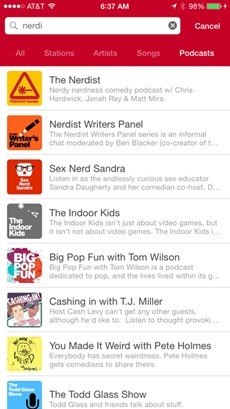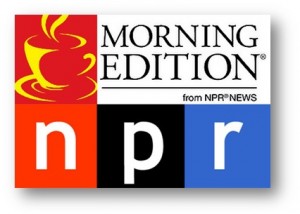 Radio’s hot streak continues, and the reasons why go to the heart of what the industry as a whole ought to be focusing on. First, Wells Fargo analyst Marcy Ryvicker upgraded radio earlier this week. Noting the gains made by NextRadio with additional telecom acceptance, as well as singling out Entercom for both ratings and revenue gains, Ryvicker upped radio in general to “overweight,” and the aforementioned Entercom to “outperform.” No one can remember the last time that happened.
Radio’s hot streak continues, and the reasons why go to the heart of what the industry as a whole ought to be focusing on. First, Wells Fargo analyst Marcy Ryvicker upgraded radio earlier this week. Noting the gains made by NextRadio with additional telecom acceptance, as well as singling out Entercom for both ratings and revenue gains, Ryvicker upped radio in general to “overweight,” and the aforementioned Entercom to “outperform.” No one can remember the last time that happened.
And then an article in USA Today earlier in the month put a point on why radio continues to make progress despite tepid advertiser perceptions. Focusing on iHeartRadio’s SVP/GM Owen Grover, the article and an accompanying video (below) take a deep dive into radio – the medium that always seems to have perceptual problems in the minds of some of its key constituencies.
Here are Grover’s key points:
Consumers are creatures of habit. Grover notes that in 1971, roughly 90% of Americans listened to the radio on a regular basis. Today (as we know), Nielsen puts weekly reach at 93%. As Grover points out, “While other media habits have ebbed and flowed, radio has remained a regular part of our daily diet.”
We often discount habitual behavior by thinking about it as robotic or passionless. But in radio’s case, becoming a part of a consumer’s daily regimen is the gift that keeps on giving. And while there’s no doubt that younger consumers are less likely to tune in radio every day, the daily routine of listening to the radio for millions of adults is one of the medium’s greatest assets.
Everywhere. Anytime. Grover notes that while broadcast radio is healthy, consumers have many digital options. The key to establishing and growing iHeartRadio was to take a consumer focus that content should be accessible “in any place they want to, wherever they expect us to be.”
From a “connected car” standpoint, iHeartRadio jumped into that space early and often, working with the automotive OEMs and Tier 1s to ensure the brand’s position in the dashboard real estate sweepstakes.
The iHeartRadio “everywhere/anytime” philosophy should be an inspiration to the entire industry, from the biggest companies in radio to every mom & pop station in small and even unrated markets.
Forget about Millennials for a moment. We know how they roll. It’s the Boomers who have changed the most in recent years, scarfing up smartphones, tablets, “connected cars,” and downloading apps from Pandora to Spotify. When tech behavior impacts the 50+ crowd, you know you’re looking at seismic media trends. iHeartRadio has put itself in a position to take advantage of the shift, and that goes a long way toward explaining its success. 
Podcasting is part of the strategy (picture at right). We’ve been covering the growing audio on-demand phenomenon in this blog, and it’s noteworthy that iHeartRadio has joined other broadcast content providers in launching podcasting initiatives.
Ask anyone who’s in the TV industry about how on-demand viewing – especially Netflix – is rocking their world. Radio will most likely follow suit.
As the USA Today article notes, celebrity is part of iHeartRadio’s podcast formula, featuring deals in place with Jared Leto and Jaime Pressly, as well as a podcast tab that allows users to access this content on the iHeartRadio platform. Smart.
Thinking BIG. This may be the one element that is most lacking across the entire radio industry – that bigger than life attitude that typified radio and its personalities back in the ‘70s and ‘80s has often gone missing in action. Bob Pittman’s show biz mindset permeates the brand, especially when you watch those iHeartRadio Music Festivals continue to make mega-waves among fans, the biggest and most popular artists, as well as in the media.
By focusing on bands as huge and diverse as Kanye West, The Who, Coldplay, The Killers, Blake Shelton George Ezra, and Janet Jackson, the Festival adds to the bigness of the brand, its unique entertainment connection, and the reinforcement of the radio industry’s relevance to pop culture.
Cross-promotion. So how does Grover explain 600 million app downloads and 70 million registered listeners? It’s simple:
“We leveraged the power of our brands, and the relationship the DJs and our personalities have with millions and millions of listeners. We told people they could listen to their favorite radio stations and their favorite DJs wherever they went, whenever they wanted to, for free.”
The most under-utilized resource in all of radio is right under our noses – the power of on-air promos and live mentions. Radio’s megaphone and influence in its hometown markets is how digital brands are built and apps are downloaded. We see this in our jācapps metrics, and iHeartRadio is living proof that consumers  will respond to a strong, well-crafted message that has reach and frequency behind it.
will respond to a strong, well-crafted message that has reach and frequency behind it.
That’s the philosophy that guided NPR CEO, Jarl Mohn, to launch the “Spark Initiative” earlier in the year, taking this logic to public radio and its Morning Edition franchise. By producing more compelling promos and running them with greater frequency, public radio stations across the U.S. were able to marshal their efforts to support the system’s most successful show.
Valuing promotional inventory ought to be done with the same care that sales managers apply to managing their precious commercial avails. Yet at most stations, the art and science of architecting strategic on-air cross-promotional activity is usually an afterthought, often left to the airstaff to sort out.
“We ate our own cooking.” OK, in the past, we’ve referred to it as dog food. Whatever you call it, doubling down on your own content, and making sure that everyone in the system uses it just like consumers, is the other piece of this pie. When Clear Channel made its broadcast stations the primary focus of the iHeartRadio platform, it showed a confidence in the core product. That’s a big part of the payoff the brand is experiencing today.
Radio’s familiarity, ease of use, credibility, along with its community presence and its personalities are the unique content that every programmer and manager is hired to focus on, to improve on, and to grow each and every day we come to work. That’s our mission..
As Grover points out, radio stations are different animals. There’s a different phenomenon in play when you’re listening to someone else choose and curate your content that you don’t get from an iPod or a service like Spotify. And radio’s habit-forming listenership reinforces just how different an experience the medium provides.
Making it better, different, and more creative is the regimen we all need to practice as the competitive environment intensifies.
Try your own cooking.
And bon appétit!
- What To Do If Your Radio Station Goes Through A Midlife Crisis - April 25, 2025
- A 2020 Lesson?It Could All Be Gone In A Flash - April 24, 2025
- How AI Can Give Radio Personalities More…PERSONALITY - April 23, 2025




And I’ll bet that over on the USA Today web site most of the comments are “Clear Channel Sucks,” “Seacrest Sucks” and “Radio is Dead.” Even considering the nature of comment boards, the message still won’t go through.
Maybe not, Mark. But for the rest of radio to study some of iHeartRadio’s moves just makes sense.
Actually the comments on the USA Today site aren’t that bad, there were ten total when I checked, and only one or two are negative towards radio. The rest were surprisingly thoughtful about how the multitude of entertainment options have changed where we listen to the radio, mostly the car now, and one commenter even attributed the tight playlists to shorter attention spans. All very interesting.
What I like about the iHeart strategy, and several other companies as well, is that they don’t consider radio dead and also don’t put all of their eggs into the digital basket. Too often the discussion around radio seems to be black and white where we are forced to choose between traditional radio and the newer digital only options. Both have value. The way forward is a combination of the two and terrestrial radio is at an advantage because Pandora and the like don’t own the car yet. And while radio may not have the same foothold on smartphones and online as Pandora and Spotify the industry is starting to flex their muscle with apps like iHeart, TuneIn and of course NextRadio.
Every aspect of the industry is changing there is no doubt, and there is a great deal more to be done industry wide to catch up. Technology is marching forward at breakneck speed and it won’t be long before wifi is available in all cars, but radio seems to be learning the important lesson of leaning into the curve instead of continuing to drive straight as the road changes. The ways we listen and everything from content to advertising have been turned upside down with no end in site for change but that is what makes it such an exciting time to be in audio entertainment.
Great stuff as always Fred, thanks.
Much appreciated, Sean. I think your “either/or” comment is spot on. The key is to excel in both the traditional sectors. When you look at Townsquare’s purchases of different types of entertainment companies they can integrate with their hundreds of radio stations, the Scripps/Midroll and Hubbard/Podcast One deals of late, and many of the iHeart examples in this post, you can see that more and more broadcasters are beginning to get aggressive via partnerships and acquisitions. Thanks again for reading our blog.
Love that podcast listing graphic… ;D
Thanks for wake up us!!! is time to release our broadcast system to past… and fly to the waves & surf to the net… jajajaja!!!